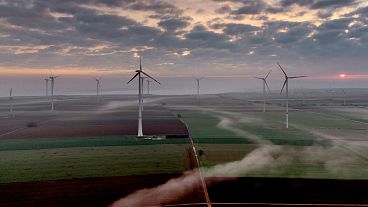40 per cent of Exxon's record-breaking profits went to new oil and gas and 5 per cent to ‘low-carbon’ initiatives.
Fossil fuel giant ExxonMobil brought in record profits last year.
The oil and gas major made a $56 billion (€51.5 bn) net profit in 2022 - around $6.3 million (€5.8 m) an hour.
Not only does this break the company’s profit record, it sets a historic high for the Western oil industry.
Why are Exxon’s profits so high?
Across the board, oil and gas giants are benefiting from soaring prices and demand fueled by Russia’s war in Ukraine.
Exxon's results for the last year far exceeded its previous record of $45.2 billion (€41.5 bn) set in 2008.
The company’s Chief Financial Officer Kathryn Mikells puts 2022’s profits down to “a combination of strong markets, strong throughput, strong production and really good cost control."
Other oil majors are also expected to announce their own annual records, pushing their combined take to nearly $200 billion (€184 bn) for 2022. Shell is set to release its earnings on Thursday followed by BP and TotalEnergies next week.
The scale of these profits has renewed criticism of the oil industry and sparked calls for more countries to levy windfall profit taxes on the companies.
What do soaring oil profits mean for windfall taxes?
A windfall tax is an extra levy imposed by a government on a company that is benefiting from something it was not responsible for.
In the case of oil and gas majors, profits are being boosted by increased demand due to COVID-19 restrictions lifting and the war in Ukraine.
A temporary windfall tax was approved by the EU in September to curb the surplus profits made by fossil fuel companies in 2022 or 2023.
Exxon says it incurred a $1.3 billion (€1.2 bn) hit to its earnings from October to December due to this tax. The company is suing the EU, arguing that the levy exceeds its legal authority.
The company’s record profit posting could renew calls for a windfall tax in the US.
Windfall profit taxes are "unlawful and bad policy," argues Mikells. Slapping new taxes on oil earnings "has the opposite effect of what you are trying to achieve," she says, adding that it would discourage new oil and gas production. The firm argues that windfall taxes discourage investments, undermine investor confidence and make Europe less competitive.
Exxon boasted that its cash flow from operations soared to $76.8 billion (€70.5 bn) last year, up from $48.1 billion (€44.2 bn) in 2021.
The company also distributed $30 billion (€27.5 bn) in cash to shareholders, more than any of its Western rivals, and invested $22.7 billion (€20.8 bn) in the business.
How much is Exxon investing in low carbon initiatives?
In 2020, a quarter of Exxon’s directors lost their seats to outsiders who rejected the company’s slow energy transition plans. Since then, it has been gradually boosting investments in lower-carbon projects.
In 2021, Exxon announced plans to invest $15 billion (€13.8 bn) in ‘lower greenhouse gas emissions initiatives’ over the next six years. It has since increased this to $17 billion (€15.7) through 2027.
This amounts to $2.8 (€2.6 bn) billion a year, or around 5 per cent of the company’s 2022 profits.
In its ‘low carbon solutions’ business model, the company focuses on carbon capture and storage, hydrogen and biofuels.
Most of the €2 billion increase through 2027 is targeted at curbing emissions from existing oil and gas operations and burying carbon underground, rather than developing renewable fuels.
At the same time, Exxon is increasing investment in oil and gas projects.
The company’s spending on new oil and gas projects went up by 37 per cent last year to $22.7 billion (€20.1 bn).
Exxon has one of the industry’s most ambitious plans to increase crude oil production over the next five years. Shell and BP are slowly cutting oil output and migrating to solar and wind power and other renewable energy projects.
Exxon aims to raise oil and gas production to a record 4.2 million barrels of oil equivalent per day by the end of 2027.



